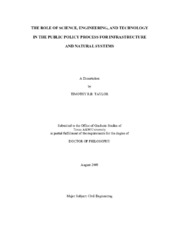| dc.description.abstract | Interactions between societal, natural, and infrastructure systems can be
beneficial or harmful to society. Society benefits from natural systems by being provided
with the basic necessities of life (air, water, and food). However, events such as
stratospheric ozone depletion demonstrate that society ultimately can be harmed by
societal impacts on natural systems. Domain knowledge is developed from observation
of natural, societal, and infrastructure systems. Domain knowledge is contained within
scientific knowledge and engineering knowledge. Scientific knowledge is gained
through structured observation and rigorous analysis of natural and societal systems.
Engineering knowledge is partially developed from scientific knowledge and is used to
manipulate natural and societal systems. Technology is the application of engineering
knowledge. In the past two centuries scientific and engineering knowledge have
produced technologies that affect the interaction between societal and natural systems.
Although scientists and engineers are in positions to advise on policies to address
problems involving societal/natural system interactions, their contributions are not
always fully utilized. This research examines feedback mechanisms that describe societal, natural, and
infrastructure system interaction to develop an improved understanding of the dynamic
interactions between society, natural systems, infrastructure systems, scientific and
engineering knowledge, technology, and public policy. These interactions are investing
through and opposing case study analysis performed using computer simulation
modeling. The stratospheric ozone depletion study represents a case in which domain
experts successfully influenced public policy. The U.S. civilian nuclear power study
represents a case in which domain experts were less successful in influencing public
policy. The system dynamics methodology is used to construct these two highly
integrated models of societal-natural system interaction. Individual model sectors, based
on existing theory, describe natural/infrastructure systems, knowledge and technology
development, societal risk perception, and public policy.
The work reveals that the influence of scientists and engineers in the public
policy is due in part to their ability to shift dominance between causal feedback
mechanisms that seek to minimize societal risk from natural systems and feedback
mechanisms that seek to minimize the economic risk of increased regulations. The
ability to alter feedback mechanism dominance is not solely dependent upon scientists
and engineers ability to develop knowledge but to a larger extent depends on their ability
to interact with policy makers and society when describing issues involving natural and
infrastructure systems. | en |


